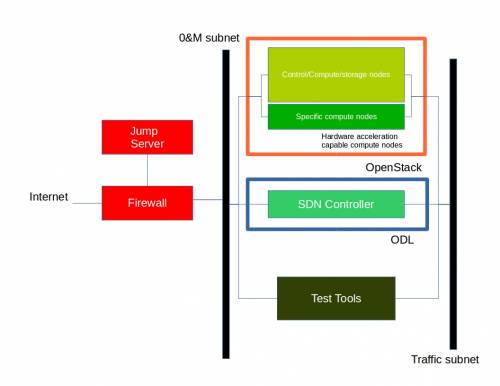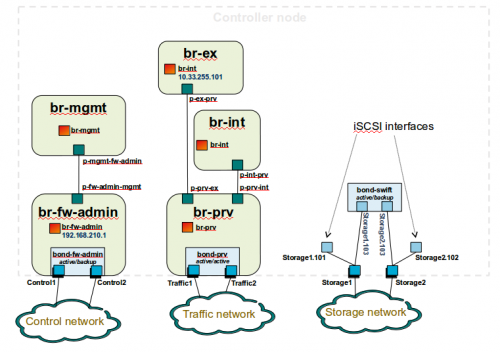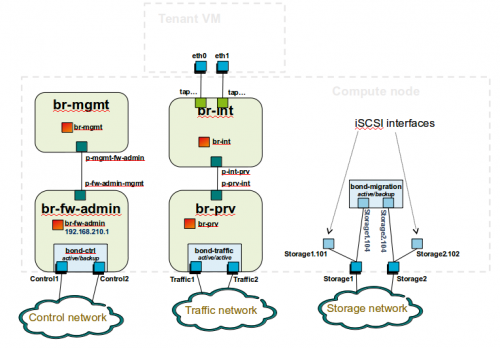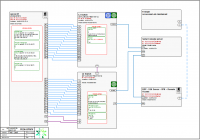pharos:pharos_specification
This is an old revision of the document!
Table of Contents
Pharos Specification
Objectives / Scope
Objectives of environment are for OPNFV platform deployment and testing with requirements to …
- Provide a secure, scalable, standard and HA environment
- Support full deployment lifecycle (this requires a bare metal environment)
- Support functional and performance testing
- Provide common tooling and test scenarios (including test cases and workloads)
- Provide mechanisms and procedures for secure remote access to the environment
Virtualized environments will be useful but do not provide a fully featured deployment/test capability
Constraints of a Pharos compliant OPNFV test-bed environment
- One jump (provisioning server) in which the installer runs in a VM
- 2 - 5 compute / controller nodes
- Jump server provisioned with CentOS7
- Installer (e.g. Foreman) runs its own DHCP server therefore management network should not have DHCP server
- Remote access
- A lights-out network is required for remote management and bare metal provisioning capability
Target Systems State (for Rls 1 follows BGS)
- Target system state includes default software components, network configuration, storage requirements https://wiki.opnfv.org/get_started/get_started_system_state
Rls 1 specification is modeled from Bootstrap/Get-started project requirements (BGS) ... * First draft of environment for BGS https://wiki.opnfv.org/get_started/get_started_work_environment * Fuel environment https://wiki.opnfv.org/get_started/networkingblueprint * Foreman environment https://wiki.opnfv.org/get_started_experiment1#topology
Hardware
Servers
CPU: * Intel Xeon E5-2600 (IvyBridge at least, or similar)
Local Storage: * Disks: 4 x 500G-2T + 1 x 300GB SSD (leave some room for experiments) * First 2 disks should be combined to form a 1 TB virtual store for the OS/Software etc * Remaining should be combined to form a virtual disk for CEPH storage * The 5'th disk (SSD) for distributed storage (CEPH) journal towards SSD technology. * Performance testing requires a mix of compute nodes that have CEPH(swift+Cinder) and without CEPH storage * Virtual ISO boot capabilities or a separate PXE boot server (DHCP/tftp or Cobbler)
Memory: * 32G RAM Minimum
Power Supply Single * Single power supply acceptable (redundant power not required/nice to have)
Pre-provisioning Jump Server
* OS - CentOS7
* KVM / Qemu
* Installer (Foreman, Fuel, ...) in a VM
* Collabration Tools
* VNC
* Test Tools
* Specified per Functest
* Foreman
* Fuel
*
Provisioning Nodes
* Controller nodes - bare metal
* Compute nodes - bare metal
Security
- Default permissions
- Server Logins
Remote management
Lights-out Management: * Out-of-band management for power on/off/reset and bare-metal provisioning * Access to server is through lights-out-management tool and/or a serial console * Intel lights-out => RMM http://www.intel.com/content/www/us/en/server-management/intel-remote-management-module.html * HP lights-out => ILO http://www8.hp.com/us/en/products/servers/ilo/index.html * CISCO UCS => https://developer.cisco.com/site/ucs-dev-center/index.gsp
Remote access
- Remote access is required for …
- Developers to access deploy/test environments (credentials to be issued per POD / user)
- Connection of each environment to Jenkins master hosted by Linux Foundation for automated deployment and test
- VPN is optional and dependent on company security rules (out of Pharos scope)
- POD access rules / restrictions …
- Refer to individual test-bed as each company may have different access rules and procedures
- Basic requirement is for SSH sessions to be established (initially on jump server)
Firewall rules
- SSH sessions
- Jenkins sessions
Networking
Test-bed network * 24 or 48 Port TOR Switch * NICS - 1GE, 10GE - per server can be on-board or PCI-e * Connectivity for each data/control network is through a separate NIC. This simplifies Switch Management however requires more NICs on the server and also more switch ports * Lights-out network can share with Admin/Management
Network Interfaces * Option 1: 4x1G Control, 2x40G Data, 48 Port Switch * 1 x 1G for ILMI (Lights out Management ) * 1 x 1G for Admin/PXE boot * 1 x 1G for control Plane connectivity * 1 x 1G for storage * 2 x 40G (or 10G) for data network (redundancy, NIC bonding, High bandwidth testing) * Option II: 1x1G Control, 2x 40G (or 10G) Data, 24 Port Switch * Connectivity to networks is through VLANs on the Control NIC. Data NIC used for VNF traffic and storage traffic segmented through VLANs * Option III: 2x1G Control, 2x10G Data, 2x40G Storage, 24 Port Switch * Data NIC used for VNF traffic, storage NIC used for control plane and Storage segmented through VLANs (separate host traffic from VNF) * 1 x 1G for IPMI * 1 x 1G for Admin/PXE boot * 2 x 10G for control plane connectivity/Storage * 2 x 40G (or 10G) for data network
Storage Network
- Needs specification
Topology
- Subnet, VLANs (want to standardize but may be constrained by existing lab setups or rules)
- IPs
- Types of NW - lights-out, public, private, admin, storage
- May be special NW requirements for performance related projects
- Default gateways
Architecture
Network Diagram
Tools
- Jenkins agent (server hosted by CI infrastructure)
- Tempest / Rally
- Robot
- Repo for test scenarios
- Jira - hosted by LF
- FAQ channel - hosted by LF
- Juju and MAAS on JUMP SERVER
Sample Network Drawings
Files for documenting lab network layout. These were contributed as Visio VSDX format compressed as a ZIP file. Here is a sample of what the visio looks like.
Download the visio zip file here: opnfv-example-lab-diagram.vsdx.zip
FYI: Here is what the OpenDaylight lab wiki pages look like.
pharos/pharos_specification.1428534956.txt.gz · Last modified: 2015/04/08 23:15 by Trevor Cooper





